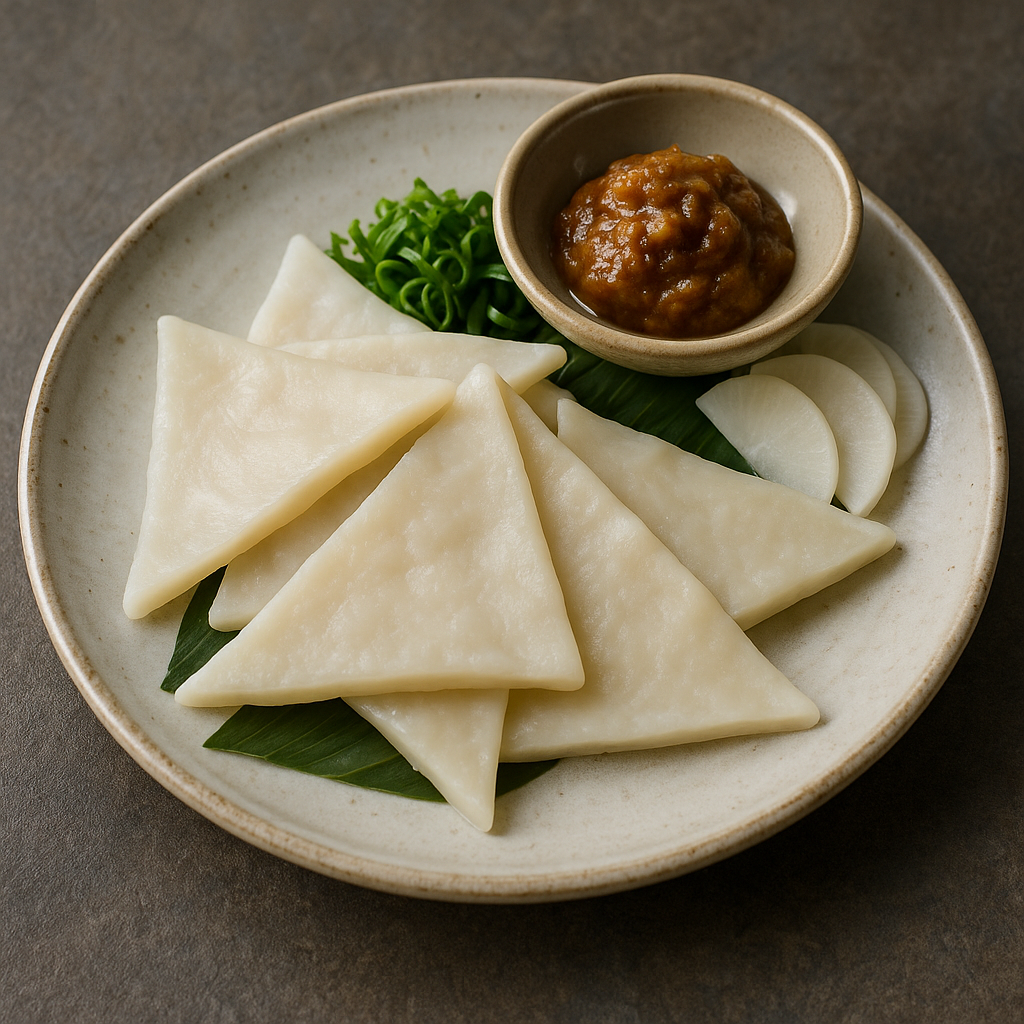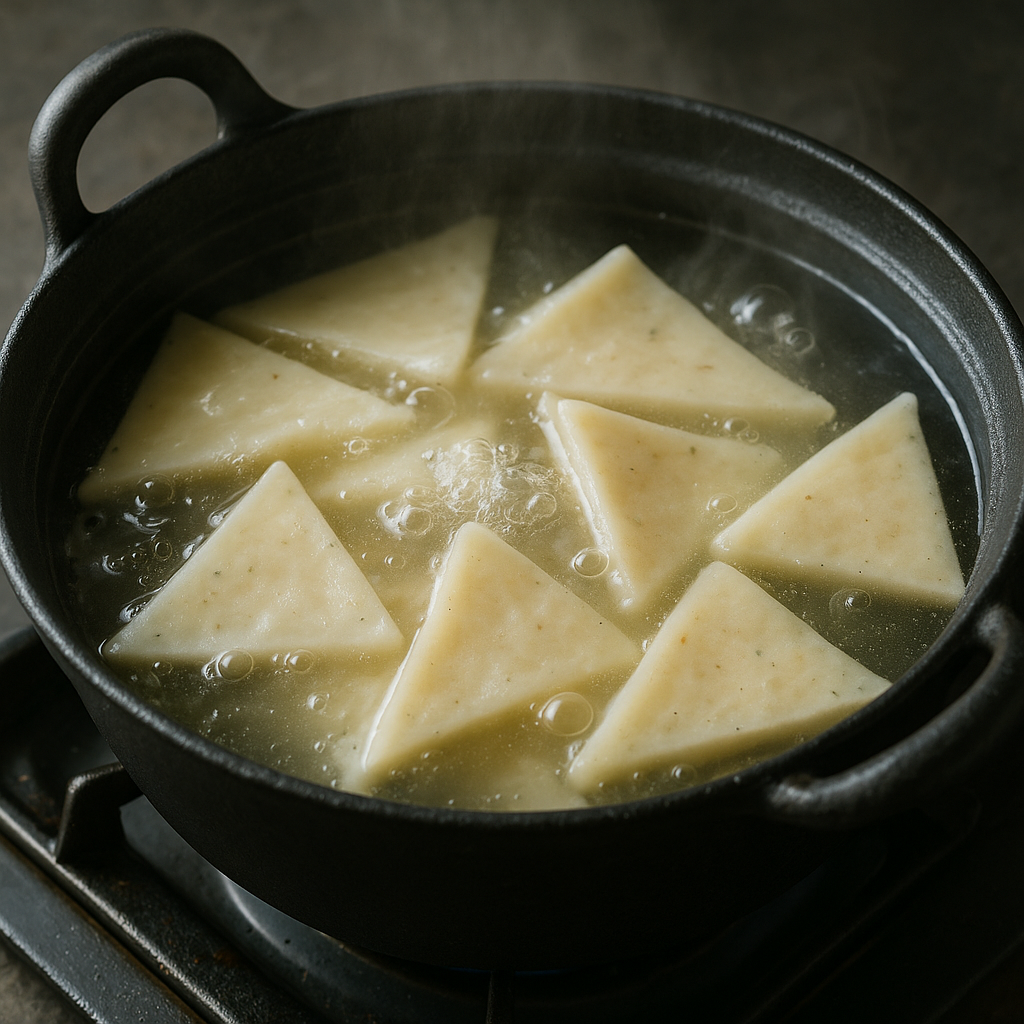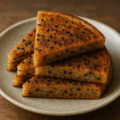
かっけ(青森)の特徴
南部地方の日常食、にんにく味噌が決め手
かっけは青森県南部地方に伝わる郷土料理。そば粉(または小麦粉)でのばした生地を三角に切って茹で、野菜や豆腐を煮た鍋から引き上げ、にんにく味噌をつけていただくのが基本です。ねぎ味噌・ごま味噌・くるみ味噌で食べることもあります(田子町はにんにくの名産地)。
“そばかっけ/むぎかっけ”と呼び名のバリエーション
そば粉のものを「そばかっけ」、小麦粉のものを「むぎかっけ」と呼ぶことがあり、三戸町・田子町・南部町あたりでは「つつけ」とも呼ばれます。
語源と伝承
「かっけ」はこの地方の言葉で“かけら”“端っこ”の意。南部藩主がそばを御法度にしたため、そばを作る際の切れ端を三角に切って練り味噌で食べたのがはじまり、といった伝承も残ります。
かっけのレシピ
材料(5人分)
- そば粉 … 400g
- 塩 … 小さじ1
- 水 … 1カップ
- 大根 … 1/2本(輪切り・下ゆで)
- 豆腐 … 1丁
- にんにく … 1片
- 味噌 … 大さじ3(にんにく味噌用)
- だし汁(昆布・干ししいたけ)… 適量
作り方
- 生地づくり:そば粉と塩を混ぜ、水でこねる。
- のばす:めん棒で厚さ約3mmにのばす。
- たたむ・切る:生地をめん棒に巻きつけて開き、中央を切って重ね、端から三角形に切る。
- だし:鍋に昆布と干ししいたけでだしをとる。
- 具:下ゆでした大根を鍋に入れる。豆腐も加える。
- 味噌:すり鉢で味噌とにんにくをよくすり、にんにく味噌を作る。
- 煮る:鍋が煮立ったら三角の生地(かっけ)を少量ずつ入れて火を通す。
- 食べ方:ゆで上がったかっけを引き上げ、にんにく味噌をつけていただく。
シェフのワンポイントアドバイス
鍋へは少量ずつ入れる事でくっつきを防ぐことが出来ます。火加減は静かに沸く程度を保ち、入れた生地が浮いてふわっとしたら食べ頃。
にんにく味噌の塩気は鍋だしの濃さに合わせて調整しましょう。
そば粉生地が扱いづらければ、打ち粉を極少量だけ使うと扱いやすくなります。
食べ方・アレンジ
出汁の鍋に野菜や豆腐を入れ、煮えたところでかっけを加えて火が通ったら引き上げ、にんにく味噌で。そばかっけは上品、むぎかっけはつるりとした喉ごしが好まれます。ゆでてあんこ・きな粉で甘味に、具を包んで揚げたり、ラザニア風に使うアレンジも広がっています。
歴史
寒冷で飢饉にも見舞われた南部地方で、雑穀・粉もの文化の中から育まれた一品。語源や殿様ご法度の伝承、地域ごとの呼称など“南部の食の記憶”が色濃く残ります。
近年は生のそばかっけ+にんにく味噌のセットなど商品化も進み、素朴なB級グルメとして全国発送・普及の取組も見られます。
English Version
Features of Kakke (Aomori)
Everyday fare of the Nanbu area—garlic miso is the key
Kakke is a local dish of Aomori’s Nanbu region. Buckwheat (or wheat) dough is rolled out, cut into triangles, and boiled. You lift the pieces from a pot simmering with vegetables and tofu and eat them with garlic miso. Scallion miso, sesame miso, or walnut miso are also common (Tago Town is famous for garlic).
Names and variations: “soba-kakke / mugi-kakke”
When made with buckwheat flour it’s called soba-kakke; with wheat flour, mugi-kakke. Around Sannohe, Tago, and Nanbu towns, it’s also known as “tsutsuke.”
Etymology and lore
“Kakke” means “scrap” or “edge” in the local dialect. A popular legend says that when the Nanbu lord forbade soba, people cut the trimmings into triangles and ate them with kneaded miso—thus the dish was born.
Recipe
Ingredients (serves 5)
- Buckwheat flour … 400 g
- Salt … 1 tsp
- Water … 1 cup (approx. 200–240 ml)
- Daikon … 1/2 (rounds; parboiled)
- Tofu … 1 block
- Garlic … 1 clove
- Miso … 3 tbsp (for garlic miso)
- Dashi (kombu & dried shiitake) … as needed
Instructions
- Make the dough: Combine buckwheat flour and salt; add water and knead.
- Roll out: Using a rolling pin, roll to about 3 mm thick.
- Fold & cut: Wrap the sheet around the pin to open, cut down the center and stack, then cut into triangles from the edge.
- Dashi: Make broth with kombu and dried shiitake.
- Fixings: Add the preboiled daikon to the pot; add tofu as well.
- Miso dip: In a suribachi (mortar), grind miso and garlic to make garlic miso.
- Cook: When the pot is gently boiling, add a few pieces of dough at a time and simmer until cooked.
- How to eat: Lift the cooked triangles and dip in the garlic miso.
Chef’s Tips
Add dough a little at a time to prevent sticking. Keep the heat at a gentle simmer; when pieces float and look slightly fluffy, they’re done. Adjust the saltiness of the garlic miso to match the broth. If buckwheat dough is hard to handle, use just a trace of dusting flour.
Serving Ideas & Variations
Simmer vegetables and tofu in the dashi, then add kakke and cook through; lift and dip in garlic miso. Soba-kakke has an elegant nuance; mugi-kakke is prized for its smooth swallow. You can also boil the triangles and serve with sweet red bean paste or kinako, wrap fillings and deep-fry, or layer like a lasagna.
History
Born from the grain-and-flour food culture of the Nanbu region, which faced cold climates and periodic famines, kakke preserves memories of local foodways—from its name and the “lord’s prohibition” tale to town-specific names. In recent years, fresh soba-kakke with garlic miso kits have been commercialized and shipped nationwide as a humble local comfort food.



何でも質問してください!